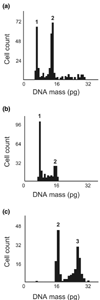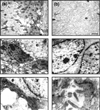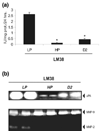Malignant myoepithelial cells are associated with the differentiated papillary structure and metastatic ability of a syngeneic murine mammary adenocarcinoma model
- PMID: 14979922
- PMCID: PMC400656
- DOI: 10.1186/bcr757
Malignant myoepithelial cells are associated with the differentiated papillary structure and metastatic ability of a syngeneic murine mammary adenocarcinoma model
Abstract
Background: The normal duct and lobular system of the mammary gland is lined with luminal and myoepithelial cell types. Although evidence suggests that myoepithelial cells might suppress tumor growth, invasion and angiogenesis, their role remains a major enigma in breast cancer biology and few models are currently available for exploring their influence. Several years ago a spontaneous transplantable mammary adenocarcinoma (M38) arose in our BALB/c colony; it contains a malignant myoepithelial cell component and is able to metastasize to draining lymph nodes and lung.
Methods: To characterize this tumor further, primary M38 cultures were established. The low-passage LM38-LP subline contained two main cell components up to the 30th subculture, whereas the higher passage LM38-HP subline was mainly composed of small spindle-shaped cells. In addition, a large spindle cell clone (LM38-D2) was established by dilutional cloning of the low-passage MM38-LP cells. These cell lines were studied by immunocytochemistry, electron microscopy and ploidy, and syngeneic mice were inoculated subcutaneously and intravenously with the different cell lines, either singly or combined to establish their tumorigenic and metastatic capacity.
Results: The two subpopulations of LM38-LP cultures were characterized as luminal and myoepithelium-like cells, whereas LM38-HP was mainly composed of small, spindle-shaped epithelial cells and LM38-D2 contained only large myoepithelial cells. All of them were tumorigenic when inoculated into syngeneic mice, but only LM38-LP cultures containing both conserved luminal and myoepithelial malignant cells developed aggressive papillary adenocarcinomas that spread to lung and regional lymph nodes.
Conclusion: The differentiated histopathology and metastatic ability of the spontaneous transplantable M38 murine mammary tumor is associated with the presence and/or interaction of both luminal and myoepithelial tumor cell types.
Figures










Similar articles
-
Hypoxia-induced nitric oxide release by luminal cells stimulates proliferation and uPA secretion of myoepithelial cells in a bicellular murine mammary tumor.J Cancer Res Clin Oncol. 2015 Oct;141(10):1727-38. doi: 10.1007/s00432-015-1934-1. Epub 2015 Feb 17. J Cancer Res Clin Oncol. 2015. PMID: 25687381 Free PMC article.
-
Myoepithelial and luminal breast cancer cells exhibit different responses to all-trans retinoic acid.Cell Oncol (Dordr). 2015 Aug;38(4):289-305. doi: 10.1007/s13402-015-0230-z. Epub 2015 Jun 5. Cell Oncol (Dordr). 2015. PMID: 26044847
-
A clinically relevant bi-cellular murine mammary tumor model as a useful tool for evaluating the effect of retinoic acid signaling on tumor progression.Breast Cancer. 2013 Oct;20(4):342-56. doi: 10.1007/s12282-012-0342-5. Epub 2012 Feb 29. Breast Cancer. 2013. PMID: 22374508
-
Stem cells in mammary gland differentiation and cancer.J Cell Sci Suppl. 1988;10:95-114. doi: 10.1242/jcs.1988.supplement_10.8. J Cell Sci Suppl. 1988. PMID: 3077945 Review.
-
Lymphatic metastasis of mammary adenocarcinoma. An experimental study in the rat with a brief review of the literature.Invasion Metastasis. 1981;1(1):34-53. Invasion Metastasis. 1981. PMID: 6765247 Review.
Cited by
-
Anti-metastatic action of an N 4-aryl substituted thiosemicarbazone on advanced triple negative breast cancer.Heliyon. 2020 Oct 6;6(10):e05161. doi: 10.1016/j.heliyon.2020.e05161. eCollection 2020 Oct. Heliyon. 2020. PMID: 33072918 Free PMC article.
-
Towards Personalized Medicine: Microdevice-Assisted Evaluation of Cancer Stem Cell Dynamics and Treatment Response.Cancers (Basel). 2025 Jun 10;17(12):1922. doi: 10.3390/cancers17121922. Cancers (Basel). 2025. PMID: 40563572 Free PMC article.
-
Hypoxia-induced nitric oxide release by luminal cells stimulates proliferation and uPA secretion of myoepithelial cells in a bicellular murine mammary tumor.J Cancer Res Clin Oncol. 2015 Oct;141(10):1727-38. doi: 10.1007/s00432-015-1934-1. Epub 2015 Feb 17. J Cancer Res Clin Oncol. 2015. PMID: 25687381 Free PMC article.
-
All-trans retinoic acid and protein kinase C α/β1 inhibitor combined treatment targets cancer stem cells and impairs breast tumor progression.Sci Rep. 2021 Mar 15;11(1):6044. doi: 10.1038/s41598-021-85344-w. Sci Rep. 2021. PMID: 33723318 Free PMC article.
-
Immunophenotypic and genomic characterization of papillary carcinomas of the breast.J Pathol. 2012 Feb;226(3):427-441. doi: 10.1002/path.3032. Epub 2011 Dec 9. J Pathol. 2012. PMID: 22025283 Free PMC article.
References
-
- Liu QY, Niranjan B, Gomes P, Gomm J, Davies D, Coombes C, Buluwela L. Inhibitory effects of activin on the growth and morphogenesis of primary and transformed mammary epithelial cells. Cancer Res. 1996;56:1155–1163. - PubMed
-
- Xiao G, Liu YE, Gentz R, sang QA, Ni J, Goldberg ID, Shi YE. Suppression of breast cancer growth and metastasis by a serpin myoepithelium derived serine protease inhibitor expressed in the mammary myoepithelial cells. Proc Natl Acad Sci. 1999;96:3700–3705. doi: 10.1073/pnas.96.7.3700. - DOI - PMC - PubMed
Publication types
MeSH terms
Substances
LinkOut - more resources
Full Text Sources
Research Materials
Miscellaneous

